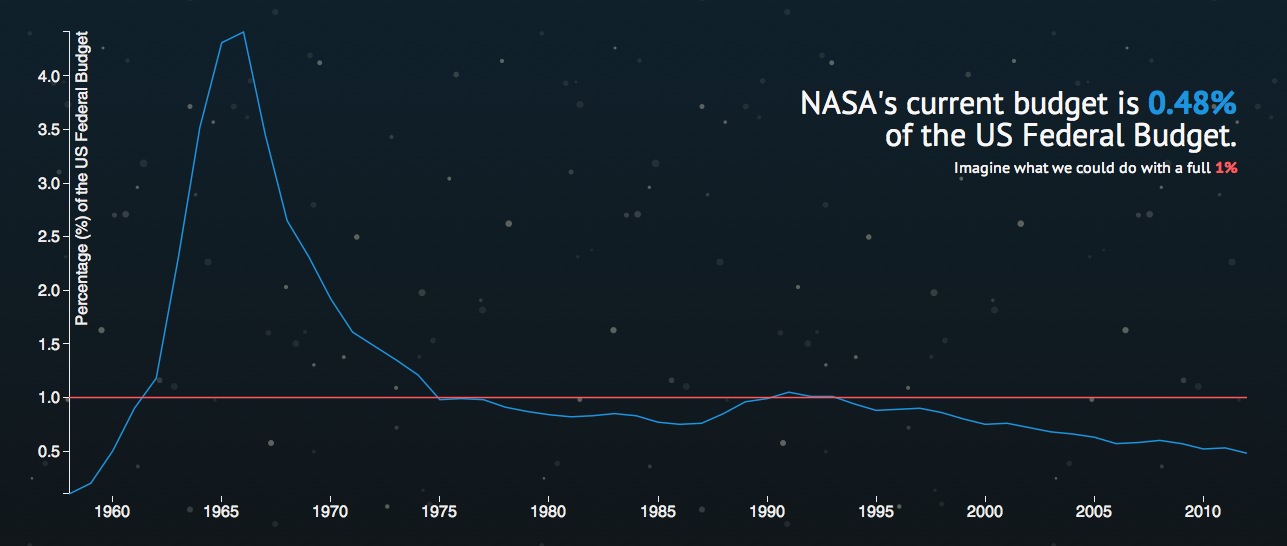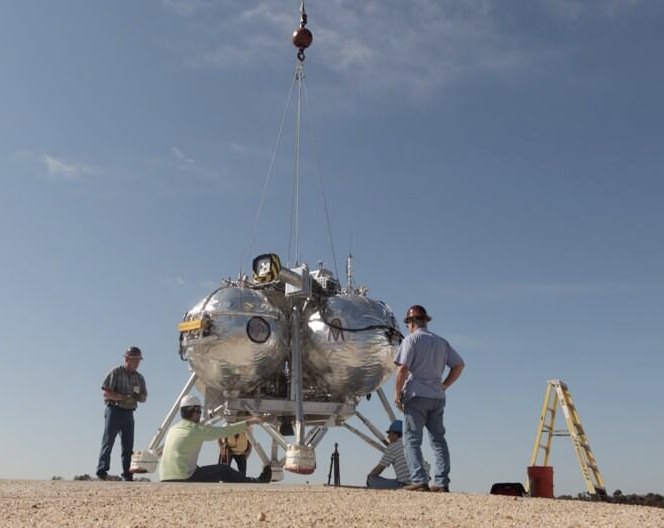This timelapse of the lunar eclipse that took place April 15, 2014 will have you checking over your shoulder for aliens! Photographer Andrew Walker shot this footage at the Caltech’s CARMA Array (Combined Array for Research in Millimeter-wave Astronomy) in the Inyo Mountains of California. You can find out more about his impressive equipment details here, but the very fitting music you may be familiar with: it’s from the movie “2001: A Space Odyssey.”
Continue reading “Dramatic Timelapse of the Recent “Blood Moon” Eclipse”
Imagine What Could Be Done With a “Penny4NASA”
If you’re reading this then you’re probably a big fan of space exploration. And while on one hand you could say that we are now living in a “golden age” of exploration, what with the ongoing missions there are around the Solar System and the new discoveries being made on an almost weekly basis about our Universe, on the other hand it seems like we are getting more and more “grounded” as human explorers, with still years to go before the first footprints are made on Mars, an ever-growing span since we last walked on the Moon, and steadily-shrinking or stagnant budgets that can’t support all the missions that DO exist — and sometimes cancel them altogether.
“We have discovered amazing places. But imagine what’s hiding where we haven’t even looked?”
In order for missions to ever get off the ground, they need to be funded. Right now NASA — still arguably the leader in space exploration among world agencies — receives a little over 0.4 percent of every U.S. tax dollar. Less than half a penny. That’s what NASA explores the Solar System with, what makes our knowledge of the Universe — from the farthest visible reaches right down to our own planet Earth — even possible. What if NASA were to receive a full one percent? A whole penny from every dollar? That’d still be only a quarter of what NASA worked with to put men on the Moon in 1969, but it’d be more than double what it gets now.
A penny for NASA… this is the goal of Penny4NASA.org, an outreach group that strives to increase the funding — if just by a little — of the world’s most accomplished, inspirational, and powerful space exploration administration. (Before… you know, it isn’t.)
The video above was created for Penny4NASA by artist and animator Brad Goodspeed, and reminds us of what NASA has achieved in its 50-year history, of what its goals are (or at least should be) and, unfortunately, why many of them have remained unattained. NASA needs support — our support — or else its candles will stay unlit and our windows and doors to the Universe will slowly but surely close.
How can you help? Well for one thing, stay excited about space and science (and get others excited too!) Interest is the key to making sure people don’t lose sight of what’s happening in the field; you might be surprised to hear the misinformation that’s been passed around. (No, NASA isn’t “dead.”) And let your policy-makers know that space exploration and the investment in technology and innovation that goes along with it is important to you — the Planetary Society has a convenient page where you can find links to write to your state representative here. And finally you can support groups like Penny4NASA, made up of enthusiastic young professionals who want to see our nation’s past successes in space exploration continued into their future.
“America is fading right now. Nobody’s dreaming about tomorrow anymore. NASA knows how to dream about tomorrow — if the funding can accommodate it, if the funding can empower it.”
– Neil deGrasse Tyson
Want more inspiration? Read this excerpt from Neil deGrasse Tyson’s Space Chronicles on TheWeek.com here.
Video credit: Brad Goodspeed/Penny4NASA.org
Take a Fly-by Of All the Known Exoplanets

Here’s a fun trip through the galaxy, put together by PhD student Tom Hands at the University of Leicester: In the above video, you can fly to of all the known exoplanets (around single stars only), ordered roughly by semi-major axis of largest orbit. Hands said the video is designed to give the viewer an overview of the current distribution of exoplanets.
Hands used data from the Open Exoplanet Catalogue.
Watch: New Documentary Follows the Hunt for Gravitational Waves
A newly released documentary brings you behind the scenes in the hunt for gravitational waves. The 20-minute film, called “LIGO, A Passion for Understanding,” follows the scientists working to create one of the most powerful scientific tools ever made: the Laser Interferometer Gravitational-Wave Observatories (LIGO). You can watch the documentary above.
Continue reading “Watch: New Documentary Follows the Hunt for Gravitational Waves”
Stunning 3D Tours of Two Well-Known Nebulae
Two videos recently released by the Hubble team take us on a tour of two famous and intriguing cosmic objects: the stellar wind-blown “celestial snow angel” Sharpless 2-106 and the uncannily equine Horsehead Nebula, imaged in infrared wavelengths by the HST.
Using Hubble imagery complemented with data from the Subaru Infrared Telescope and ESO’s Visible and Infrared Survey Telescope for Astronomy — VISTA, for short — the videos show us an approximation of the three-dimensional structures of these objects relative to the stars surrounding them, providing a perspective otherwise impossible from our viewpoint on Earth.
The stellar nursery Sharpless 2-106 is above; hop on the Horsehead Nebula tour below:
Continue reading “Stunning 3D Tours of Two Well-Known Nebulae”
Bill Nye on Taking Astronomy with Carl Sagan
“This is how we know nature. It is the best idea humans have ever come up with.”
– Bill Nye, Science Guy and CEO of The Planetary Society
In this latest video from NOVA’s Secret Life of Scientists and Engineers, science guy Bill Nye talks about the incredible influence that Carl Sagan had on his life, from attending his lectures on astronomy at Cornell University to eventually becoming CEO of The Planetary Society, which was co-founded by Sagan in 1980.
“I took astronomy from Carl Sagan.” Now there’s a statement that’ll get people’s attention. (It got mine, anyway.)
Morpheus Flies Higher and Farther Than Ever
)
NASA’s Project Morpheus nailed it again today with yet another successful free flight of their prototype lander, soaring higher, faster, and farther than ever before! Go Morpheus!
The FF9 test, which occurred at 3:41 p.m. EDT at Kennedy Space Center, saw the 2,300-lb (1000-kg) Morpheus craft rise to a height of 580 feet (177 meters) and travel 837 feet (255 m) downrange at 30 mph (48 km/h). After the 85-second flight the craft set down almost exactly on target — only about a foot (.3 m) off.
During today’s test flight the oxygen-and-methane-propelled Morpheus could have cleared the Washington Monument.
The next step is to integrate the Autonomous Landing and Hazard Avoidance Technology (ALHAT) sensors, which allow the craft to identify dangerous terrain and determine the best route to a safe landing — all by itself. This capability will be invaluable for future landings on unexplored surfaces on the Moon and Mars.
“It’s never been done,” said Dr. Jon Olansen, project manager of the Morpheus Project, in 2012. “We’ve never landed of the moon or Mars with real-time hazard detection and avoidance. Most of the Mars missions use air bags. They go where they go, they roll them and they stop… whatever comes, comes.”
Check out the latest incredible free flight video above, and learn more about Project Morpheus here.
Source: NASA
UPDATE: Here’s the “official” NASA video of FF9, showing some fantastic camera views from the craft itself:
)
NASA Engineer Answers 4-Year-Old’s Questions With a Personal Video
Like many kids his age, 4-year-old Lucas Whiteley is fascinated about space and astronauts and has a lot of questions to ask. Unlike most kids, though, Lucas got his answers directly from a NASA engineer, with a custom-made video no less!
Continue reading “NASA Engineer Answers 4-Year-Old’s Questions With a Personal Video”
Playing Marbles With The Planets
We’ve all seen charts showing the relative sizes of planets and moons compared to each other, which are cool to look at but don’t really give a sense of the comparative masses of the various worlds in our Solar System. It’s one thing to say the Earth is four times larger than the Moon, it’s entirely another to realize it’s 87 times more massive!
That’s where this new animation from astrophysicist Rhys Taylor comes in nicely.
Where Did Earth’s Water Come From?
Anyone who’s ever seen a map or a globe easily knows that the surface of our planet is mostly covered by liquid water — about 71%, by most estimates* — and so it’s not surprising that all Earthly life as we know it depends, in some form or another, on water. (Our own bodies are composed of about 55-60% of the stuff.) But how did it get here in the first place? Based on current understanding of how the Solar System formed, primordial Earth couldn’t have developed with its own water supply; this close to the Sun there just wouldn’t have been enough water knocking about. Left to its own devices Earth should be a dry world, yet it’s not (thankfully for us and pretty much everything else living here.) So where did all the wet stuff come from?
As it turns out, Earth’s water probably wasn’t made, it was delivered. Check out the video above from MinuteEarth to learn more.
*71% of Earth’s surface, yes, but actually less total than you might think. Read more.
MinuteEarth (and MinutePhysics) is created by Henry Reich, with Alex Reich, Peter Reich, Emily Elert, and Ever Salazar. Music by Nathaniel Schroeder.
UPDATE March 2, 2014: recent studies support an “alien” origin of Earth’s water from meteorites, but perhaps much earlier in its formation rather than later. Read more from the Harvard Gazette here.


